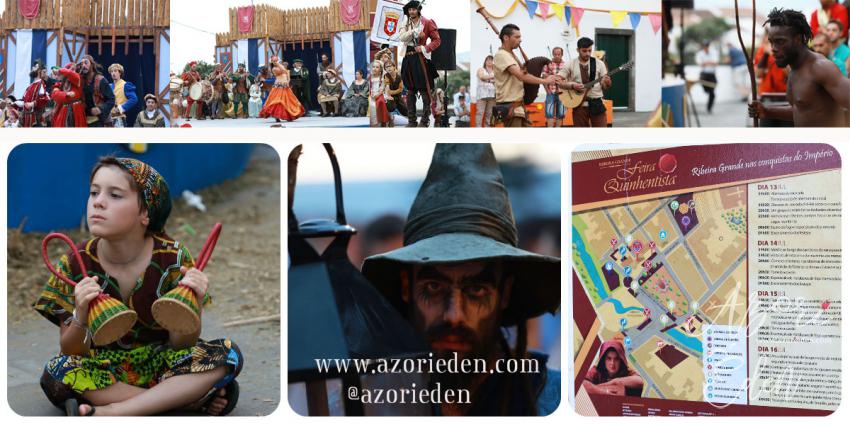Feira Quinthentista – What do native Africans and a medieval fair on the Azores have in common?
Yesterday I have been to a wonderful medieval fair in the town of Riberia Grande. The name of the fair in Portuguese is: Feira Quinhentista na Ribeira Grande 2017. This fair has been somewhat different compared to the festivals I have attended before, however in all of these events dancing and music are the core elements. The fair lasts for a week, with different programs and activities every day. There was a horse show, theater, singing and dancing, and of course fireworks every evening. I came upon the African Court, which has been a very essential part of the fair, with lots of African dance shows. But what exactly have native Africans and the a medieval fair on the Azores have in common?
But first, a few thoughts about the fair. The same way like in case of the other festivals on the islands, visitors of all ages wore medieval costumes and took an active part in the activities. All food sold at the venue had medieval names, and in some cases even the preparation method has been medieval – which I found fantastic! You can read about the culinary highlights of the fair in the BIO Girl on the Azores – Gastronomy Blog section.














OK, so let’s focus on the main question: what exactly have native Africans and the a medieval fair on the Azores have in common? I got the answer from a girl at the festival and also from Wikipedia. Africa is mentioned several times in the article describing the history of Portugal, so this is where the connection is coming from. Among the settlers that, from 1432 onwards, arrived to the Azores Islands were individuals of North and sub-Saharan African origin.
Let’s take a look at the history of Portugal until the 15th century.
Early in the first millennium BC, several waves of Celts invaded Portugal from Central Europe. Romanization began with the arrival of the Roman army in the Iberian Peninsula in 218 BC. The Romans founded numerous cities, and left important cultural legacies in what is now Portugal. Vulgar Latin (the basis of the Portuguese language) became the dominant language of the region. In 409, with the decline of the Roman Empire, the Iberian Peninsula was occupied by Germanic tribes (Visigoths). In 711 Berber commander Tariq ibn-Ziyad brought most of the Visigothic kingdom under Muslim occupation in a seven-year campaign. In 718 AD, a Visigothic noble and elected leader named Pelagius called for a rebellion against the Moors (Reconquista).
It the end of the 9th century a small minor county based in the area of Portus Cale was established by Vímara Peres on the orders of King Alfonso III. After annexing the County of Portugal into one of the several counties that made up its realms, King Alfonso III named Vímara Peres as its first count in 868. Portugal traces its national origin to June 24, 1128 when Afonso Henriques proclaimed himself Prince of Portugal. In 1143 the Kingdom of León recognized him as King of Portugal. The Algarve, the southernmost region of Portugal, was finally conquered from the Moors in 1249, and in 1255 the capital shifted to Lisbon.
During the 15th and 16th centuries, Portugal became a leading European power that ranked with England, France and Spain in terms of economic, political and cultural influence. Though not dominant in European affairs, Portugal did have an extensive colonial trading empire throughout the world backed by a powerful thalassocracy. The beginnings of the Portuguese Empire can be traced to 25 July 1415, when the Portuguese Armada – led by Prince Henry the Navigator – set sail for the rich Islamic trading center of Ceuta in North Africa. Further steps were taken that would soon expand the Portuguese Empire much further. Between 1427 and 1431, most of the Azores were discovered and these uninhabited islands were colonized by the Portuguese in 1445. Among the settlers that, from 1432 onwards, arrived to the Azores Islands were individuals of North and sub-Saharan African origin.
In 1434, Gil Eanes passed Cape Bojador, south of Morocco. The trip marked the beginning of the Portuguese exploration of Africa. In 1448, on the small island of Arguim off the coast of Mauritania, an important castle was built to function as a feitoria, or trading post, for commerce with inland Africa. Some time later, the caravels explored the Gulf of Guinea, which led to the discovery of several uninhabited islands: Cape Verde, Fernão Póo, São Tomé, Príncipe and Annobón. In 1471, the Portuguese captured Tangier, after years of attempts. Eleven years later, the fortress of São Jorge da Mina in the town of Elmina on the Gold Coast in the Gulf of Guinea was built. In 1483, Diogo Cão reached and explored the Congo River.
